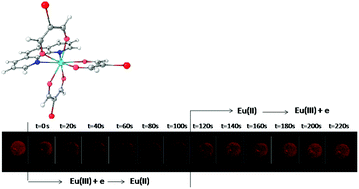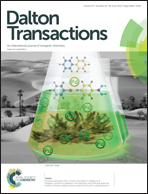Yttrium and lanthanide complexes of β-dialdehydes: synthesis, characterization, luminescence and electrochemistry of coordination compounds with the conjugate base of bromomalonaldehyde†
Abstract
Novel yttrium, europium and terbium coordination compounds having formulae [AsPh4][Ln(BrMA)4] (6Ln), Ln(BrMA)3(bipyO2) (7Ln), Ln(NMA)3(phen) (8Ln) and Ln(NMA)3(terpy) (9Ln) (Ln = Y, Eu, Tb; BrMA = conjugate base of bromomalonaldehyde; bipyO2 = 2,2′-bipyridine-N,N′-dioxide; phen = 1,10-phenantroline; terpy = 2,2′:6′,2′′-terpyridine) were synthesized and characterized by using spectroscopic and electrochemical techniques. Uncharged europium and, to a lesser extent, terbium complexes showed appreciable luminescence in the solid state upon excitation with UV light. Polymeric materials and ionic liquids containing BrMA and lanthanides were prepared and photoluminescence measurements were carried out. From an electrochemical point of view, europium(III) BrMA-complexes showed a quasi-reversible one-electron reduction process. The one electron transfer reaction Eu(III) to Eu(II) allowed the photoluminescence tuning of 8Eu deposited on the surface of a glassy carbon electrode.


 Please wait while we load your content...
Please wait while we load your content...